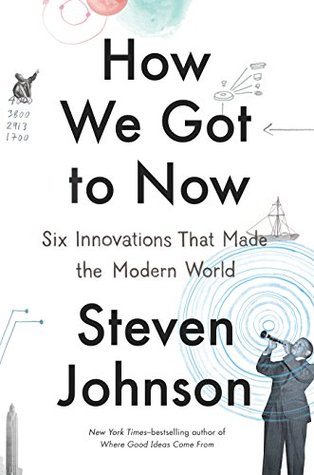More on this book
Community
Kindle Notes & Highlights
Read between
September 10, 2016 - June 11, 2018
This hybrid of two seemingly unrelated inventions—the concentrated, orderly light of lasers, and the hyper-clear glass fibers—came to be known as fiber optics.
Today, the backbone of the global Internet is built out of fiber-optic cables. Roughly ten distinct cables traverse the Atlantic Ocean, carrying almost all the voice and data communications between the continents.
before mirrors came along, the average person went through life without ever seeing a truly accurate representation of his or her face, just fragmentary, distorted glances in pools of water or polished metals.
“How from these ashes, by the mere intensity of [heat’s] action, it formed glass: for as this transmutation of ashes into glass appeared to me as wonderful as any other nature,
(Even today, Americans are far more likely to enjoy ice with their beverages than Europeans, a distant legacy of Tudor’s ambition.)
when you have a leap forward in the accuracy of measuring something, new possibilities emerge.
The primary system for sanitation removal was scavenging pigs roaming the streets, devouring the refuse that the humans left behind.
Building by building, Chicago was lifted by an army of men with jackscrews.
Once again, an increase in our ability to measure things turned out to be as important as our ability to make them.
A day was no longer the time it took the earth to complete one rotation. A day became 86,400 atomic seconds, ticked off on 270 synchronized atomic clocks around the world.
When your phone tries to figure out its location, it pulls down at least three of these time stamps from satellites, each reporting a slightly different time thanks to the duration it takes the signal to travel from satellite to the GPS receiver in your hand. A satellite reporting a later time is closer than one reporting an earlier time. Since the satellites have perfectly predictable locations, the phone can calculate its exact position by triangulating among the three different time stamps.
It’s an idea that Einstein would have appreciated: measuring time turns out to be key to measuring space.
One of the odd things about artificial light is how stagnant it was as a technology for centuries. This is particularly striking given that artificial light arrived via the very first technology, when humans originally mastered the controlled fire more than a hundred thousand years ago. The Babylonians and Romans developed oil-based lamps, but that technology virtually disappeared during the (appropriately named) Dark Ages. For almost two thousand years, all the way to the dawn of the industrial age, the candle was the reigning solution for indoor lighting. Candles made from beeswax were
...more
(His famous quip about invention being one percent inspiration and ninety-nine percent perspiration certainly holds true for his adventures in artificial light.)
By any measure, Edison was a true genius, a towering figure in nineteenth-century innovation. But as the story of the lightbulb makes clear, we have historically misunderstood that genius. His greatest achievement may have been the way he figured out how to make teams creative: assembling diverse skills in a work environment that valued experimentation and accepted failure, incentivizing the group with financial rewards that were aligned with the overall success of the organization, and building on ideas that originated elsewhere.
Edison famously said. “I am quite correctly described as ‘more of a sponge than an inventor.’”
If we think that innovation comes from a lone genius inventing a new technology from scratch, that model naturally steers us toward certain policy decisions, like stronger patent protection. But if we think that innovation comes out of collaborative networks, then we want to support different policies and organizational forms: less rigid patent laws, open standards, employee participation in stock plans, cross-disciplinary connections.
When lasers did finally enter our lives, they turned out to be lousy for weapons, but brilliant for something the sci-fi authors never imagined: figuring out the cost of a stick of chewing gum.
Don’t be trapped by dogma—which is living with the results of other people’s thinking. Don’t let the noise of others’ opinions drown out your own inner voice. And most important, have the courage to follow your heart and intuition.
If there’s anything we know from the history of innovation—and particularly from the history of the time travelers—it is that being true to yourself is not enough.


